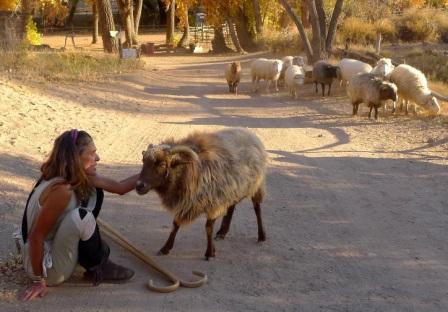Shepherdess fears flock is going astray

AMATA BOCELLA, the modern-day shepherdess we wrote about in December 2012, is no longer tending the flock at El Rancho de las Golondrinas living history museum in Cienaga. Because of a dispute with their longtime volunteer, the ranch stopped having her bring the flock out to the fields, as she did several times a week for the better part of a decade.
“They kicked me out after 13 years of service and terminated my decade-long no-kill program,” she wrote to us in December. “Golondrinas decided they wanted to go back to running the sheep program ‘like a ranch.’”
Golondrinas’ director John Berkenfield declined to go into why the ranch ended Bocella’s role as volunteer shepherdess, but denied it was to return to butchering sheep. He said there had been no change to the museum’s “Sheep to Blanket” program, which illustrates for visitors the role that Churro Sheep played in colonial Spain, from shearing to weaving.
“The program continues and thrives,” he said, noting that the museum keeps sheep to fulfill its educational mission. “Amata was involved only in part of it—exercising our sheep, primarily.” The flock continues to be tended by museum staff, he said, though the animals no longer walk in the fields.
Bocella, whose experience at the ranch led her to found The Sheep Sanctuary in 2003, expressed grief at no longer being able to see the flock, which she socialized and named. Her uncanny ability to understand the family relationships and social interactions of the sheep had been the subject of our earlier profile. “These are my children,” she sobbed in March, grieved that the flock would go back to being treated like livestock.
Bocella explained that she had brought home her “star sheep” Lambina after the 12-year-old suffered a compound fracture at the ranch and was left untreated for two days. This followed a fracture suffered earlier in the year by Lambina’s offspring, Losar Dorje, whom she also brought home to treat. In the fall, she was told that none of them were welcome back at the ranch.
Most distressing, she said, is the flock’s “palpable grief” at being separated from Lambina, their alpha ewe. In December, Bocella wrote a 16-page letter to the ranch directors protesting her treatment. As of March, nothing had come of it, she said, despite attempts by her attorney to make contact.
According to Berkenfield, the ranch parted ways with Bocella over differences about how the sheep program was run.
“I’m not going to say anything negative about Amata,” he said, expressing admiration for her years of service. “Disagreements often come from people’s personalities and how well you respond to other people. A lot of our interaction is based on personalities, and oftentimes personalities clash “I’m not going to go into the reasons for our differences, which is between us,” he added. “We very much valued Amata’s help to us over the years, but time goes on.”
He said the sheep would be getting a larger enclosure this summer that would allow them more room to roam, and more visibility to the public. Bocella’s sheep interactions, he noted, usually took place after hours, when the public could not benefit from them.
“We’re not taking them on the same long walks, and we don’t know all their names, but we are still taking care of them in the same way,” he said.
El Rancho de las Golondrinas was turned into a museum in 1972. Historically the last stop on the Camino Real before Santa Fe, it was owned by various prominent families before being devoted to its current purpose by the Curtin-Paloheimo family in the 1930s, significant promoters of Spanish colonial art in Santa Fe. The museum employs 12 employees and has about 150 volunteers. Bocella and her sheep appear often in the museum's promotional materials, and on the website.
High-risk breeds get help
The ASPCA in February added Albuquerque to a handful of communities nationwide to get special help in tackling its overpopulation of homeless pets.
The nation’s oldest animal-welfare organization has awarded $178,000 to the Albuquerque Animal Welfare Department and nonprofit Animal Humane New Mexico to help improve the city’s “live release” rate to 84.4 percent of cats and dogs, from 82.4 percent. The live release rate counts animals reunited with owners, transferred, or adopted.
The award, which can be extended for up to five years, will be used to target high-risk neighborhoods and breeds for spay/neuter and adoption, such as Chihuahua and Pit Bull mixes. In Albuquerque, those breeds represent around 60 percent of dogs in shelters.
The ASPCA Partnership was launched in 2007 and “graduates” communities that have achieved their goals. This year only two communities were added to the program, Albuquerque and Charlotte, N.C.
